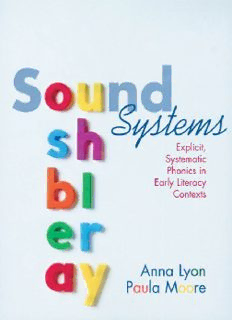
Sound Systems: Explicit, Systematic Phonics in Early Literacy Contexts PDF
Preview Sound Systems: Explicit, Systematic Phonics in Early Literacy Contexts
Sound Systems Explicit, Systematic Phonics in Early Literacy Contexts Anna Lyon Assistant Professor, East Carolina University Paula Moore Director and Coordinator, Center for Early Literacy, University of Maine Stenhouse Publishers Portland, Maine Sound Systems: Explicit, Systematic Phonics in Early Literacy Contextsby Anna Lyon and Paula Moore. Copyright © 2003. Stenhouse Publishers. All rights reserved. No reproduction without written permission from the publisher. Stenhouse Publishers www.stenhouse.com Copyright © 2003 by Anna Lyon and Paula Moore All rights reserved. No part of this publication may be reproduced or transmitted in any form or by any means, electronic or mechanical, including photocopy, or any information storage and retrieval system, without permission from the publisher. Every effort has been made to contact copyright holders and students for per- mission to reproduce borrowed material. We regret any oversights that may have occurred and will be pleased to rectify them in subsequent reprints of the work. Credit Page 32: From Crabs, Shrimps, and Lobsters by Stanley L. Swartz. Illustrated by Robert I. Yin. Copyright © 1997. Reprinted with permission of Dominie Press, Inc. Library of Congress Cataloging-in-Publication Data Lyon, Anna. Sound systems: explicit, systematic phonics in early literacy contexts / Anna Lyon, Paula Moore. p. cm. Includes bibliographical references (p. ) and index. ISBN 1-57110-346-5 (alk. paper) 1. Reading—Phonetic method. 2. Reading (Early childhood) I. Moore, Paula (Paula F.) II. Title. LB1050.34.L96 2003 372.46’5—dc21 2002026821 Cover photography by Andrew Edgar Manufactured in the United States of America on acid-free paper 08 07 06 05 04 03 02 9 8 7 6 5 4 3 2 1 Sound Systems: Explicit, Systematic Phonics in Early Literacy Contextsby Anna Lyon and Paula Moore. Copyright © 2003. Stenhouse Publishers. All rights reserved. No reproduction without written permission from the publisher. To Matthew, Joey, Ben, and Collin and all the children who have taught us so much. Sound Systems: Explicit, Systematic Phonics in Early Literacy Contextsby Anna Lyon and Paula Moore. Copyright © 2003. Stenhouse Publishers. All rights reserved. No reproduction without written permission from the publisher. This page intentionally left blank Contents Preface vii Part 1: Research on Phonics Chapter 1: Some Clues from Research to Guide Phonics Curriculum, Assessment, and Instruction 1 Chapter 2: A Developmental Perspective on Phonics Curriculum 10 Part 2: Systematic Assessment and Record Keeping Chapter 3: Phonics Assessments in Reading 22 Chapter 4: Phonics Assessments in Writing 40 Chapter 5: Making It Systematic: Keeping Records 56 Part 3: Explicit, Systematic Phonics Instruction Chapter 6: Instructional Methods 67 Chapter 7: Instruction at the Prephonemic Stage 73 Chapter 8: Instruction at the Emergent Stage 82 Chapter 9: Instruction at the Early Stage 91 Chapter 10:Instruction at the Transitional Stage 103 Chapter 11:A Summary of Principles 115 Appendixes A–J 119 References 157 Index 163 v Sound Systems: Explicit, Systematic Phonics in Early Literacy Contextsby Anna Lyon and Paula Moore. Copyright © 2003. Stenhouse Publishers. All rights reserved. No reproduction without written permission from the publisher. This page intentionally left blank Preface Learning to read is a complex process that involves the integration of many cognitive, motor, and perceptual abilities. In this book we focus on the narrow domain of phonics instruction. We are concerned that as the cry for systematic phonics instruction becomes louder and louder at the national level, there may be a tendency in some schools for systematic phonics to be interpreted as “skill ’n drill” or back-to-the-workbook activities. There may also be a tendency for teachers and administrators, anxious to meet the demands of politi- cians, to adopt fixed-sequence, commercial phonics programs, ignoring that some children know a great deal about phonics before they start school, and some children know very little. We were both first-grade teachers for some time before moving to university teaching. We both taught phonics from workbooks in a fixed sequence prescribed by the publisher. We know first-hand that fixed- sequence phonics instruction worked for some learners, but not for many others. The purpose of our book is to support teachers who know that a fixed-sequence phonics program cannot possibly fit all learners. We pro- pose phonics instruction that is explicit, systematic, grounded in research, and taught in authentic early literacy contexts across the liter- acy block and content areas. Throughout the book we give examples of classrooms where teach- ers are teaching phonics systematically and explicitly, not as an add-on but as part of their comprehensive approach to literacy instruction. Children in these classrooms are learning how to use phonics to read and write. vii Sound Systems: Explicit, Systematic Phonics in Early Literacy Contextsby Anna Lyon and Paula Moore. Copyright © 2003. Stenhouse Publishers. All rights reserved. No reproduction without written permission from the publisher. This page intentionally left blank Part Research on Phonics Chapter 1 Some Clues from Research to Guide Phonics Curriculum, Assessment, and Instruction The effects of systematic early phonics instruction were significant and substantial in kindergarten and the 1st grade, indicating that systematic phonics programs should be implemented at those age and grade levels. (NICHHD 2000a, p. 10) As we walk into Ms. Chandler’s kindergarten classroom, we hear the class participating in a shared book reading session enthusi- astically chanting: Run, run, As fast as you can. You can’t catch me. I’m the Gingerbread Man! The children eagerly follow Ms. Chandler’s pointer with their eyes as character after character in The Gingerbread Man (Parkes and Smith 1986) is taunted by the refrain. A shared reading session is under way, and every child in the class is engaged in the rereading of this long-time favorite book. 1 Sound Systems: Explicit, Systematic Phonics in Early Literacy Contextsby Anna Lyon and Paula Moore. Copyright © 2003. Stenhouse Publishers. All rights reserved. No reproduction without written permission from the publisher.
